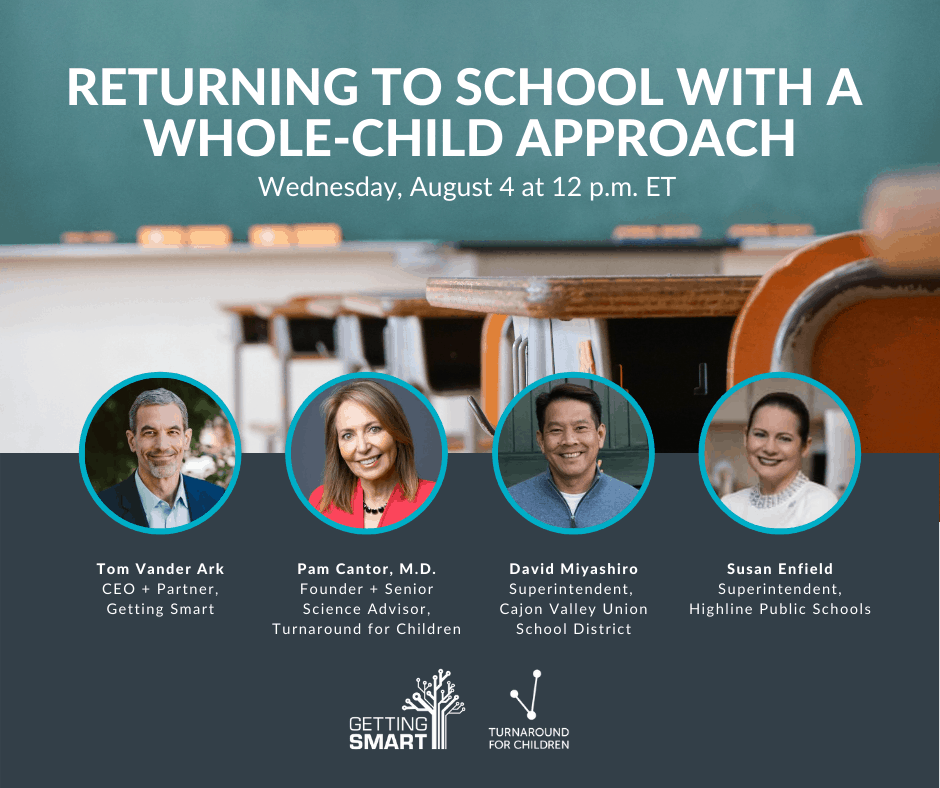
Recap: A Fireside Chat About Returning to School With a Whole-Child Approach
“It’s not about how you carve out space for a whole child agenda, the whole child IS THE AGENDA”
Last week, we co-hosted a live fireside chat event alongside our friends at Turnaround for Children. We gathered Dr. Pamela Cantor as well as two of our favorite district leaders David Miyashiro of Cajon Valley and Susan Enfield of Highline School District, to talk about the urgency of whole-child education, and why now is the perfect time to begin planning a whole-child strategy.
These district leaders were chosen for the important and innovative work that they do but they also were chosen because of the way their vision statements manifest in action. The Highline SD Promise is that “Every student in Highline Public Schools is known by name, strength and need, and graduates prepared for the future they choose.” For Cajon Valley the vision is, “Happy Kids, Engaged in Healthy Relationships, on a Path to Gainful Employment”.
Throughout the event, our international audience asked great questions that challenged pre-conceptions and worked towards a better understanding of learning science: “When we think about the 3 most important principles of development, the malleability is the most important. #2 is experience-dependent growth. Those are primary drivers in who we become and the skills we develop. #3 is the overwhelming role of context,” said Dr. Cantor in reply to one attendee’s question. “It is possible to create learning environments in a system that recognizes children as whole people and sees them in that system. We do need a new design, mapped to the way the brain grows and children learn.”
The conversation eventually shifted towards a concentration on making sure that adults aren’t left out of the equation. “We have to make sure we have whole adults.” This ranged from prioritizing teacher wellbeing to ensuring that parents are more involved in the process: “We got a window into our students’ lives and homes this past year and what came out of that as a positive is families realized how much they need teachers and staff realized how much they need families and parents in order to make sure our students are thriving. Tech plays a huge role here. We now have a vehicle to engage with families,” said Susan.
Check out the links that were shared in chat for great whole-child resources.
The attendees also shared the following thoughts and questions:
- Jeanine Collins asked: “I’m wondering about how measurement drives our continued focus on a sort of disconnected approach to learning and teaching. If we are going to examine our policies and practices (and culture) to embrace whole-child principles — what do we need to measure that we aren’t, and how do we support systems in making such a huge shift so that as Dr. Miyashiro said, we don’t just have schools where “the test scores are improving but the outcomes aren’t?”
- Scott Ellis asked: “How can we help educators change their current view of how they should spend their time, so we can free up more of their time to do the critical things we are discussing today?”
- Amanda Pickett said: “I have been doing a lot of support around connecting our behavioral and emotional supports being embedded in instruction – through instructional practices and content/curriculum. It can’t be seen as a separate content area or reserved for a block of time. I always caution people to be careful with emotion/SEL work. Much of it was NOT developed with a cultural sustaining lens. I’m weary of kindness messages instead of social justice messages.”
- Barry Brinkley said: “We have to re-examine policies and structures. How do we create spaces that fit our students’ needs (based on student and community voice) and not punish students for not fitting what we think they need.
- Simone asked: “Susan talked about the vital need of enacting deep cultural shifts in order to catalyze shifts in practice. What have Susan and David learned and what thoughts does Pam have about how and where to start with this process so that culture doesn’t eat strategy for breakfast? In my work with school districts (and probably most orgs), the cultural shifts are the hardest and take the longest to dislodge.”
- Shari Barrera said “We use the Zones of Regulation program in our school now. We check which Zone every child is in daily. We help children find personal ways of dealing with their emotions. We have seen a huge decrease in behaviors as a result.”
What’s Next?
Our town hall next month will focus on learning goals. In particular, how to create an inclusive process for establishing learner goals, how to make sure that they are actually being used to their fullest potential and how to embed them in your communication, curriculum and culture. Register now for Learning Goals That Matter: Bringing to Life a Shared Vision for Your Graduates & Community.
For more, see:
Stay in-the-know with innovations in learning by signing up for the weekly Smart Update.
Stay connected with us on social media platform for instant update click here to join our Twitter, & Facebook
We are now on Telegram. Click here to join our channel (@TechiUpdate) and stay updated with the latest Technology headlines.
For all the latest Education News Click Here
For the latest news and updates, follow us on Google News.

